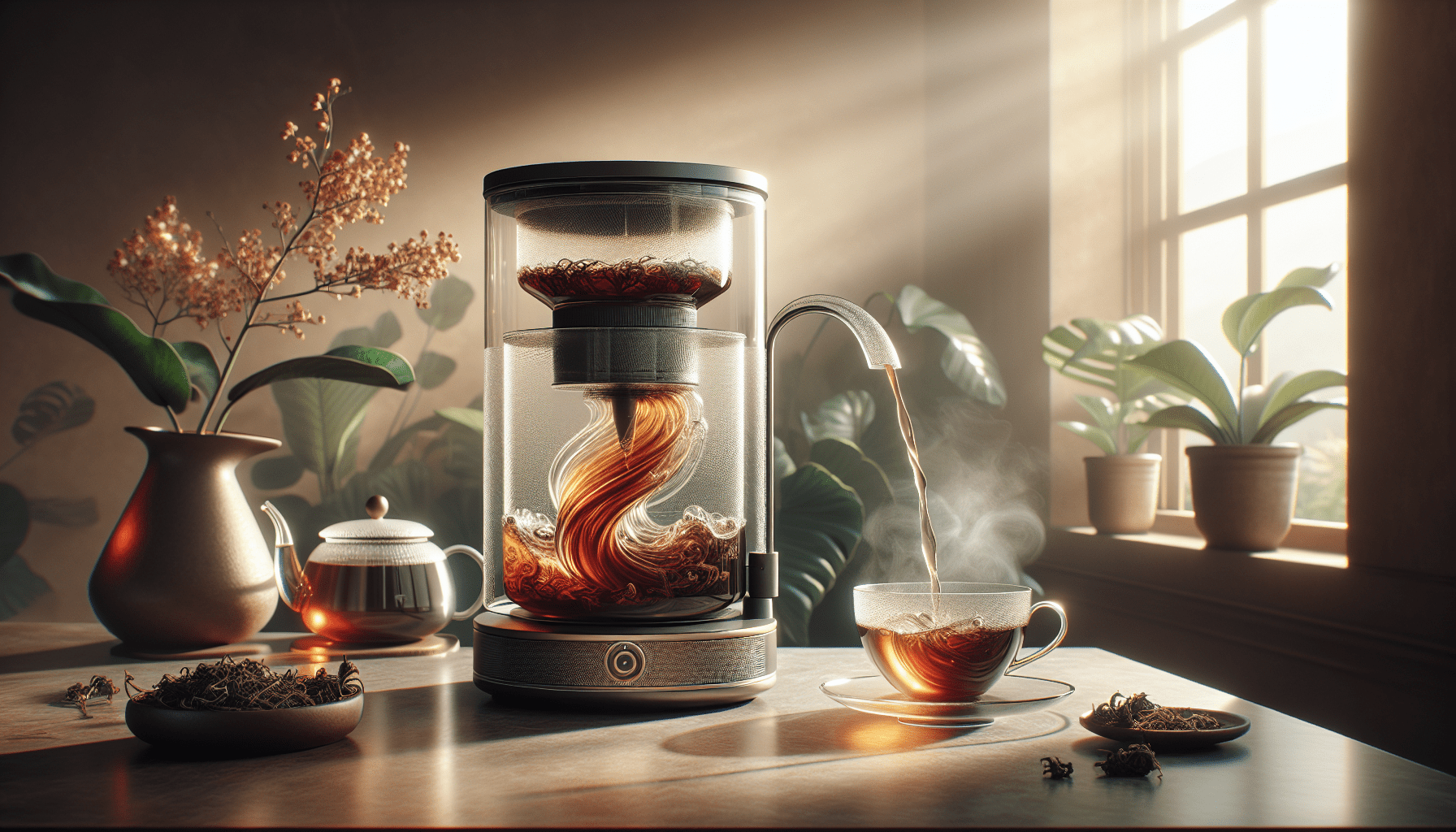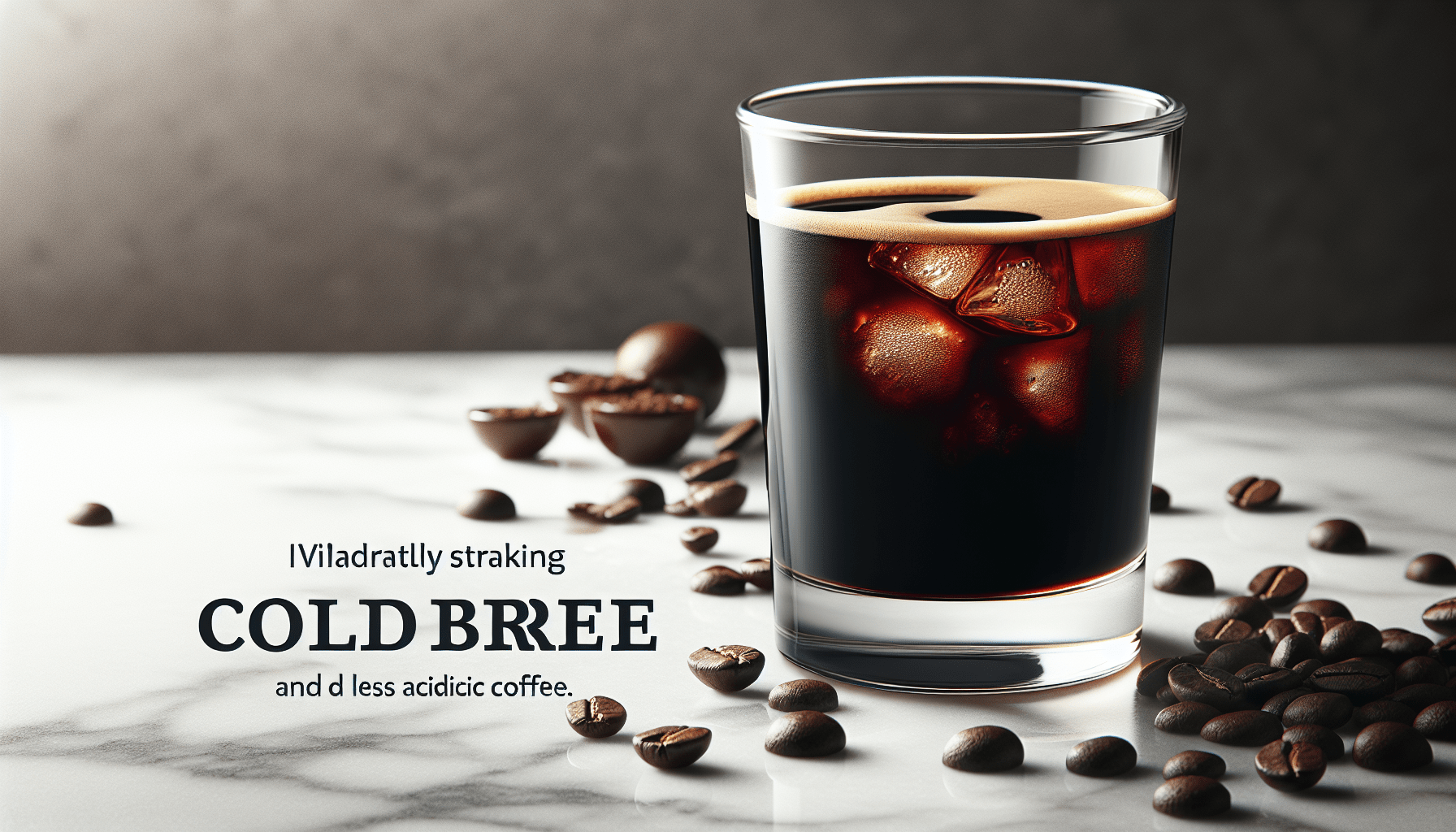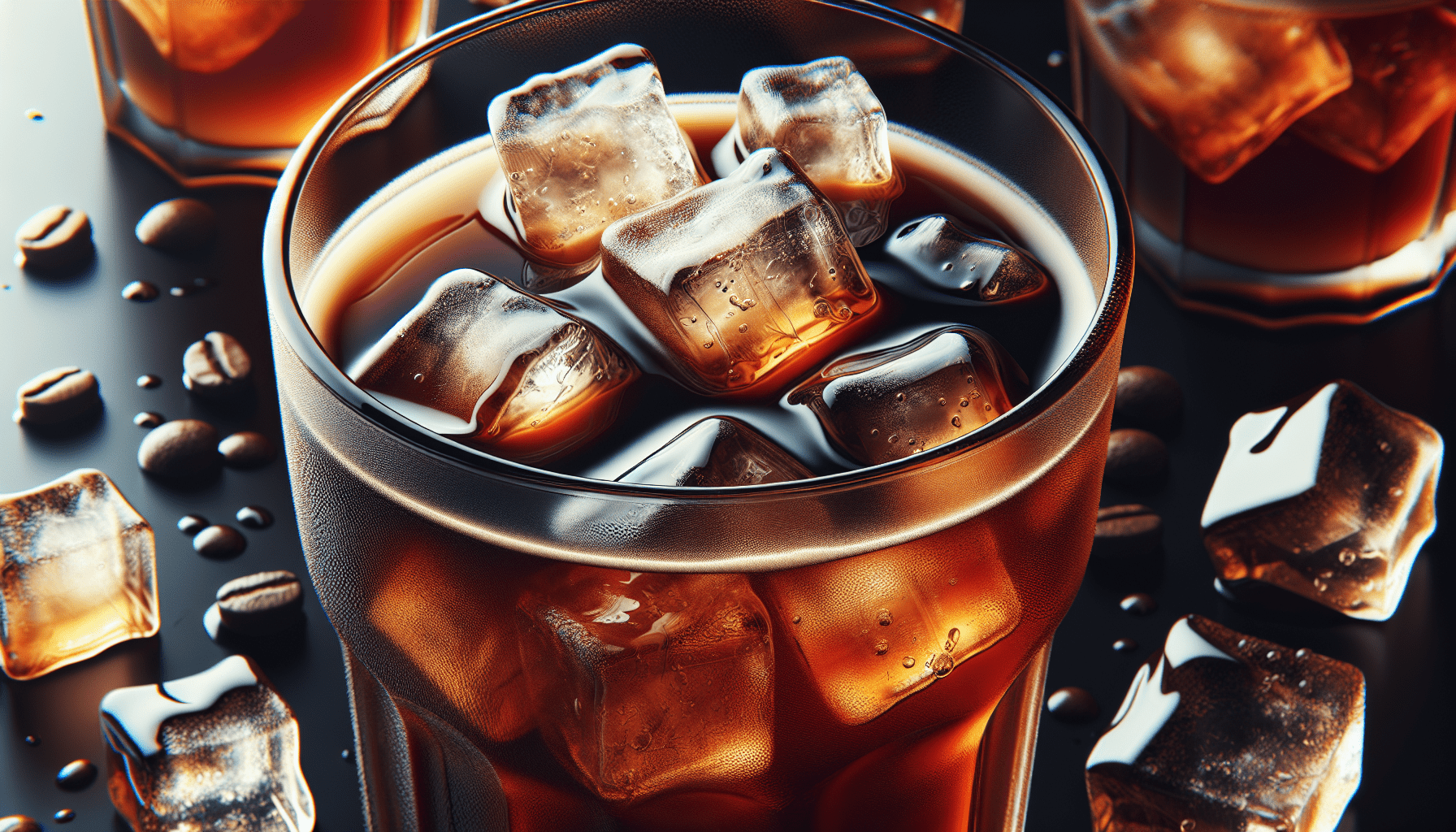Ever wondered if you can use a cold brew maker for brewing loose leaf tea? Well, wonder no more! In this article, we will explore the possibilities of using a cold brew maker to create that perfect cup of tea using loose leaves. Whether you’re a tea enthusiast or just looking for a new way to enjoy your favorite beverage, this article will guide you through the process and help you achieve that rich and flavorful brew. So grab a cup of tea and let’s get started!
Understanding Cold Brew Coffee Makers
Definition of a cold brew coffee maker
A cold brew coffee maker is a specialized device designed to brew coffee using the cold brewing method. It typically consists of a carafe or pitcher with a filtered or perforated basket to hold coffee grounds. Cold brew coffee makers are known for their ability to extract rich flavors from the coffee beans by slowly steeping them in cold water for an extended period of time.
How a cold brew coffee maker works
Unlike traditional coffee makers that use hot water to extract flavors quickly, cold brew coffee makers rely on the slow steeping process to produce a smooth and low-acidity coffee concentrate. The coffee grounds are immersed in cold or room temperature water and left to steep for an extended period, usually ranging from 12 to 24 hours. The slow extraction process allows for a more gentle extraction of flavors, resulting in a less acidic and smoother coffee concentrate.
Benefits of using a cold brew coffee maker
Using a cold brew coffee maker offers several benefits. Firstly, the slow extraction process highlights the natural sweetness of the coffee beans while minimizing the acidity, making cold brew coffee a preferable option for people with sensitive stomachs. Additionally, the concentrated coffee produced by cold brew coffee makers can be stored and diluted with water or milk, allowing for customized serving sizes and strengths. Cold brew coffee is also suitable for iced coffee preparations, as the concentrate can be poured over ice without losing its flavor intensity. Overall, using a cold brew coffee maker allows coffee enthusiasts to explore a different flavor profile and enjoy a refreshing cup of coffee.
Brewing Loose Leaf Tea in a Cold Brew Coffee Maker
Similarities between coffee and tea brewing
While they have their differences, brewing loose leaf tea in a cold brew coffee maker shares some similarities with the coffee brewing process. Both coffee and tea require proper water-to-leaf ratios, an appropriate steeping time, and the right temperature to extract flavors effectively. The cold brew coffee maker’s ability to slow down the extraction process makes it suitable for brewing tea, as it provides ample time for the tea leaves to infuse and release their flavor compounds.
Adjusting brewing parameters for loose leaf tea
When brewing loose leaf tea in a cold brew coffee maker, it’s essential to adjust the brewing parameters to suit the characteristics of tea leaves. Unlike coffee, which can withstand longer brewing times, tea leaves are more delicate and can become bitter if steeped for too long. It is recommended to reduce the steeping time compared to coffee, typically ranging from 2 to 8 hours, depending on the type of tea.
Recommended types of loose leaf tea for cold brewing
While most types of loose leaf tea can be brewed using a cold brew coffee maker, certain varieties are particularly well-suited for this method. Herbal teas, such as chamomile, mint, and fruit infusions, are highly compatible with cold brewing due to their naturally delicate flavors. Green teas, with their grassy and vegetal taste profiles, can also be successfully brewed in a cold brew coffee maker. Experimenting with different tea varieties will allow you to discover unique flavor combinations that suit your taste preferences.
Considerations Before Brewing Tea in a Cold Brew Coffee Maker
Compatibility of a cold brew coffee maker for tea brewing
Before attempting to brew tea in a cold brew coffee maker, it is important to check if the specific model is suitable for tea brewing. Some cold brew coffee makers have additional filters or features that may need to be removed when brewing tea to avoid flavor contamination or improper steeping. Therefore, it is recommended to refer to the manufacturer’s instructions or consult customer support to ensure the machine is compatible with tea brewing.
Potential risk of flavor contamination
When using a cold brew coffee maker for both coffee and tea brewing, there is a possibility of flavor contamination. Strong coffee residue or leftover coffee oils may transfer to the brewed tea, altering its taste. To minimize this risk, it is crucial to thoroughly clean the coffee maker between uses, following the recommended cleaning and maintenance instructions provided by the manufacturer.
Cleaning and maintenance requirements
To maintain optimal flavor integrity and prevent flavor contamination, it is vital to clean the cold brew coffee maker thoroughly after each use. The cleaning process may involve disassembling the components, such as the filter basket, and washing them with warm water and gentle soap. It is essential to follow the manufacturer’s instructions for cleaning and maintenance to ensure the longevity of the coffee maker.
Steps to Brew Loose Leaf Tea in a Cold Brew Coffee Maker
Choosing the right amount of tea leaves
To achieve the desired flavor intensity, it is important to select the appropriate amount of tea leaves. As a general guideline, use one to two tablespoons of loose leaf tea for every 8 ounces of water. However, this can be adjusted based on personal preference and the strength of the tea leaves used.
Selecting water temperature and steeping time
Different types of tea require specific water temperatures and steeping times for optimal flavor extraction. For example, green and white teas are best brewed with water that is around 170°F to 185°F (77°C to 85°C) for 2 to 4 hours, while herbal teas can be steeped with cooler water at around 160°F (71°C) for 4 to 8 hours. Refer to the packaging or consult a tea brewing guide for specific recommendations based on the type of tea leaves.
Properly placing the tea leaves in the coffee maker
Before placing the tea leaves in the cold brew coffee maker, make sure to pre-rinse them with cold water to remove any dust or impurities. Then, carefully place the pre-rinsed tea leaves in the filter basket or designated infusion chamber of the coffee maker, ensuring that they are evenly distributed for consistent flavor extraction.
Filling the coffee maker with water
Once the tea leaves are in place, fill the cold brew coffee maker with cold or room temperature water. The water level should be sufficient to cover the tea leaves entirely, ensuring proper infusion. It’s important not to overfill the coffee maker to avoid any potential overflow during the steeping process.
Determining the steeping time
The steeping time for loose leaf tea in a cold brew coffee maker may vary depending on personal preference and the type of tea leaves used. Start with the recommended steeping time provided for the specific tea variety, and then adjust it according to your taste preferences. Remember that shorter steeping times are generally recommended for delicate teas, while stronger teas can withstand longer steeping periods.
Removing the tea leaves and filtering the tea
After the desired steeping time has elapsed, carefully remove the filter basket or infusion chamber containing the tea leaves from the coffee maker. Gently press or squeeze the tea leaves to extract any remaining liquid. To ensure a smooth and sediment-free tea, pour the steeped tea through a fine-mesh sieve or a tea strainer into a clean container before serving or storing.
Alternative Methods for Brewing Loose Leaf Tea
Traditional steeping in a teapot or infuser
One of the most common methods for brewing loose leaf tea is to use a teapot or infuser. Simply add the desired amount of tea leaves into the infuser or teapot, pour hot water over the leaves, and let them steep for the appropriate amount of time. Once the tea is steeped, the leaves can be removed, and the tea is ready to be served or poured over ice for iced tea.
Using a French press for loose leaf tea
Another alternative method for brewing loose leaf tea is to use a French press. Add the desired amount of tea leaves into the French press, pour hot water over the leaves, and let them steep for the recommended time. Once the steeping is complete, press down the plunger slowly to separate the tea leaves from the liquid. The brewed tea can then be poured into cups or a pitcher for serving.
Making iced tea with a pitcher and tea bags
For a quick and simple iced tea preparation, tea bags can be used with a pitcher. Fill a pitcher with cold or room temperature water, add the desired number of tea bags, and let them steep for the recommended time. Once the tea has reached the desired strength, remove the tea bags and refrigerate the pitcher until chilled. Serve the chilled tea over ice and garnish with lemon or mint, if desired.
Advantages and Disadvantages of Using a Cold Brew Coffee Maker for Tea
Advantages of using a cold brew coffee maker
Using a cold brew coffee maker for tea brewing offers several advantages. Firstly, the slow extraction process of cold brewing allows for a smoother and less bitter tea, making it suitable for individuals who prefer a milder flavor profile. The cold brew coffee maker also simplifies the brewing process, requiring minimal effort and monitoring. Additionally, the ability to brew larger quantities of tea in one batch makes it convenient for preparing iced teas or keeping a ready-to-drink container in the refrigerator.
Disadvantages of using a cold brew coffee maker
While the cold brew coffee maker can be a convenient tool for brewing tea, there are some disadvantages to consider. One major drawback is the potential risk of flavor contamination when using the same machine for brewing both coffee and tea. Without thorough cleaning between uses, residual coffee flavors may impact the taste of the brewed tea. Additionally, the lengthy steeping time required for cold brewing may not be suitable for individuals who prefer a quick tea preparation method.
Tips for a Better Tea Brewing Experience with a Cold Brew Coffee Maker
Experiment with different tea varieties and blends
One of the exciting aspects of brewing tea in a cold brew coffee maker is the opportunity to explore different tea varieties and blends. Try experimenting with various types of tea, such as black, green, herbal, or oolong, to discover new flavor combinations and find your personal favorites. Mixing different teas or adding herbs and spices can also create unique and delightful brews.
Adjust steeping time and water-to-tea ratio
As brewing parameters can significantly impact the flavor profile of the tea, don’t be afraid to adjust the steeping time and water-to-tea ratio according to your taste preferences. Steeping for shorter or longer durations, as well as increasing or reducing the tea leaves used, can result in variations in strength and intensity. It may take a few trials to find the perfect balance that suits your palate.
Use filtered water for optimal taste
To enhance the overall tea experience, it is recommended to use filtered or purified water when brewing. Tap water may contain impurities or chlorine that can affect the flavor and aroma of the tea. Using filtered water ensures a clean and neutral base, allowing you to fully appreciate the nuances and complexities of the tea leaves.
Clean the coffee maker thoroughly after each use
To prevent flavor contamination and maintain the quality of your brewed tea, it is essential to clean the cold brew coffee maker thoroughly after each use. Ensure that all components, including the filter basket, are washed with warm water and gentle soap. Pay attention to any crevices or hard-to-reach areas where coffee residues may accumulate. Regular and proper cleaning will keep the coffee maker in optimal condition and preserve the taste of your brewed tea.
Store the brewed tea in airtight containers
If you have leftover brewed tea or want to prepare a larger batch in advance, it is advisable to store the tea in airtight containers to maintain its freshness and flavor. Exposure to air can cause the tea to oxidize and lose its aromatic qualities. An airtight container will help preserve the tea’s flavors and prevent any external odors from permeating the tea.
FAQs about Brewing Tea in a Cold Brew Coffee Maker
Can I reuse the tea leaves for multiple brews?
Reusing tea leaves for multiple brews is possible, depending on the type of tea and the strength of the initial infusion. Generally, black, oolong, and herbal teas can withstand multiple infusions, while green and white teas may be suitable for one or two additional brews. However, each subsequent brew will have a milder taste and aroma compared to the first infusion.
Can I add milk or sweeteners to cold brewed tea?
Yes, you can add milk or sweeteners to cold brewed tea according to your preferences. Cold brewed tea provides a great base for creating various flavor combinations, such as adding honey or lemon for a refreshing twist. Experiment with different additions and ratios to find your ideal combination.
Can I drink cold brewed tea hot?
While cold brewed tea is typically enjoyed chilled or over ice, it can be heated if desired. In this case, simply warm the cold brewed tea on the stove or in the microwave until the desired temperature is reached. Heating the tea may slightly alter the flavor profile, so it is recommended to taste and adjust accordingly.
Is there any risk of excessive caffeine extraction?
Cold brewing tea generally extracts less caffeine than hot brewing methods. The slower extraction process of cold brewing results in a lower caffeine content in the final cup. However, it is important to note that the exact caffeine content can vary depending on the type of tea used and the brewing parameters. If you are particularly sensitive to caffeine, it may be advisable to choose lower-caffeine teas or limit your consumption.
Can I use a cold brew coffee maker for herbal teas?
Yes, a cold brew coffee maker can be used for brewing herbal teas. Herbal teas, which are typically caffeine-free and made from various parts of plants, are well-suited for cold brewing due to their delicate and subtle flavors. Experimenting with different herbal tea blends can lead to refreshing and flavorful results.
Conclusion
Using a cold brew coffee maker for brewing loose leaf tea can open up a world of flavorful possibilities. While there are considerations to keep in mind, such as flavor contamination and cleaning requirements, the advantages, such as milder flavor profiles and convenience, make it a worthwhile option for tea enthusiasts. By adjusting brewing parameters, experimenting with different tea varieties, and following these tips, you can enhance your tea brewing experience and find your personal favorite flavors. Remember, brewing tea is a personal journey, and exploring different methods and techniques allows you to tailor your tea to your unique taste preferences. Cheers to delicious and refreshing cups of tea brewed in a cold brew coffee maker!




